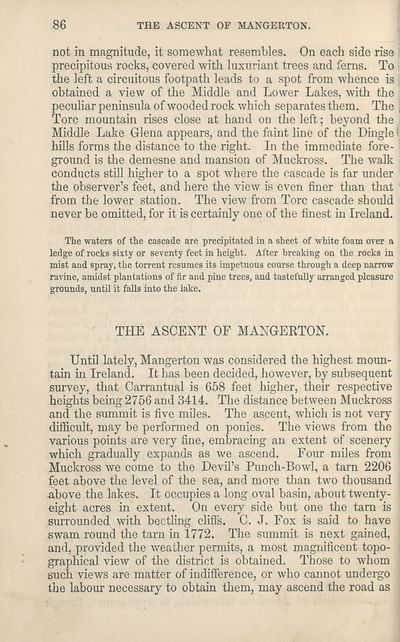Download files
Complete book:
Individual page:
Thumbnail gallery: Grid view | List view

THE ASCENT OF MANGERTON.
not in magnitude, it somewhat resembles. On each side rise i
precipitous rocks, covered with luxuriant trees and ferns. To :
the left a circuitous footpath leads to a spot from whence is !
obtained a view of the Middle and Lower Lakes, with the |
peculiar peninsula of wooded rock which separates them. The j
Tore mountain rises close at hand on the left; beyond the !
Middle Lake Glena appears, and the faint line of the Dingle (
hills forms the distance to the right. In the immediate fore- 1
ground is the demesne and mansion of Muckross. The walk
conducts still higher to a spot where the cascade is far under !
the observer’s feet, and here the view is even finer than that ‘
from the lower station. The view from Tore cascade should
never be omitted, for it is certainly one of the finest in Ireland.
The waters of the cascade are precipitated in a sheet of white foam over a
ledge of rocks sixty or seventy feet in height. After breaking on the rocks in
mist and spray, the torrent resumes its impetuous course through a deep narrow
ravine, amidst plantations of fir and pine trees, and tastefully arranged pleasure
grounds, until it falls into the lake.
THE ASCENT OF MANGEKTON.
Until lately, Mangerton was considered the highest moun¬
tain in Ireland. It has been decided, however, by subsequent
survey, that Carrantual is 658 feet higher, their respective
heights being 2756 and 3414. The distance between Muckross
and the summit is five miles. The ascent, which is not very ,
difficult, may be performed on ponies. The views from the
various points are very fine, embracing an extent of scenery
which gradually expands as we ascend. Four miles from
Muckross we come to the Devil’s Punch-Bowl, a tarn 2206
feet above the level of the sea, and more than two thousand j
above the lakes. It occupies a long oval basin, about twenty-
eight acres in extent. On every side but one the tarn is ■
surrounded with beetling cliffs. C. J. Fox is said to have
swam round the tarn in 1772. The summit is next gained,
and, provided the weather permits, a most magnificent topo- |
graphical view of the district is obtained. Those to whom i
such views are matter of indifference, or who cannot undergo
the labour necessary to obtain them, may ascend the road as ;
not in magnitude, it somewhat resembles. On each side rise i
precipitous rocks, covered with luxuriant trees and ferns. To :
the left a circuitous footpath leads to a spot from whence is !
obtained a view of the Middle and Lower Lakes, with the |
peculiar peninsula of wooded rock which separates them. The j
Tore mountain rises close at hand on the left; beyond the !
Middle Lake Glena appears, and the faint line of the Dingle (
hills forms the distance to the right. In the immediate fore- 1
ground is the demesne and mansion of Muckross. The walk
conducts still higher to a spot where the cascade is far under !
the observer’s feet, and here the view is even finer than that ‘
from the lower station. The view from Tore cascade should
never be omitted, for it is certainly one of the finest in Ireland.
The waters of the cascade are precipitated in a sheet of white foam over a
ledge of rocks sixty or seventy feet in height. After breaking on the rocks in
mist and spray, the torrent resumes its impetuous course through a deep narrow
ravine, amidst plantations of fir and pine trees, and tastefully arranged pleasure
grounds, until it falls into the lake.
THE ASCENT OF MANGEKTON.
Until lately, Mangerton was considered the highest moun¬
tain in Ireland. It has been decided, however, by subsequent
survey, that Carrantual is 658 feet higher, their respective
heights being 2756 and 3414. The distance between Muckross
and the summit is five miles. The ascent, which is not very ,
difficult, may be performed on ponies. The views from the
various points are very fine, embracing an extent of scenery
which gradually expands as we ascend. Four miles from
Muckross we come to the Devil’s Punch-Bowl, a tarn 2206
feet above the level of the sea, and more than two thousand j
above the lakes. It occupies a long oval basin, about twenty-
eight acres in extent. On every side but one the tarn is ■
surrounded with beetling cliffs. C. J. Fox is said to have
swam round the tarn in 1772. The summit is next gained,
and, provided the weather permits, a most magnificent topo- |
graphical view of the district is obtained. Those to whom i
such views are matter of indifference, or who cannot undergo
the labour necessary to obtain them, may ascend the road as ;
Set display mode to:
![]() Universal Viewer |
Universal Viewer | ![]() Mirador |
Large image | Transcription
Mirador |
Large image | Transcription
| Antiquarian books of Scotland > Ireland/Irish > Black's guide to Killarney and the south of Ireland > (98) |
|---|
| Permanent URL | https://digital.nls.uk/118861844 |
|---|
| Description | Thousands of printed books from the Antiquarian Books of Scotland collection which dates from 1641 to the 1980s. The collection consists of 14,800 books which were published in Scotland or have a Scottish connection, e.g. through the author, printer or owner. Subjects covered include sport, education, diseases, adventure, occupations, Jacobites, politics and religion. Among the 29 languages represented are English, Gaelic, Italian, French, Russian and Swedish. |
|---|

